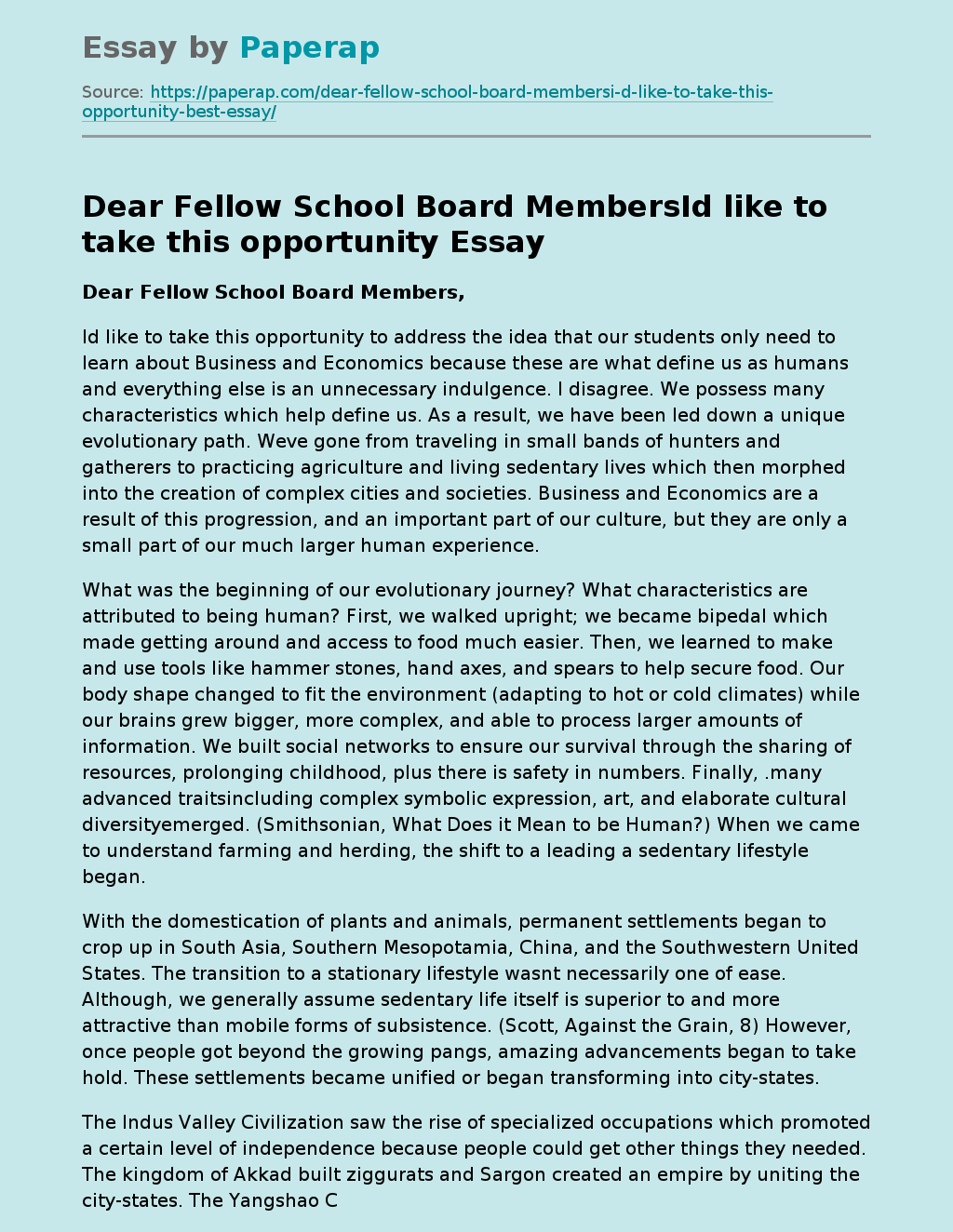What Are Business and Economics For?
We possess many characteristics which help define us. As a result, we have been led down a unique evolutionary path. Weve gone from traveling in small bands of hunters and gatherers to practicing agriculture and living sedentary lives which then morphed into the creation of complex cities and societies. Business and Economics are a result of this progression, and an important part of our culture, but they are only a small part of our much larger human experience.
What was the beginning of our evolutionary journey? What characteristics are attributed to being human? First, we walked upright; we became bipedal which made getting around and access to food much easier.
Then, we learned to make and use tools like hammer stones, hand axes, and spears to help secure food. Our body shape changed to fit the environment (adapting to hot or cold climates) while our brains grew bigger, more complex, and able to process larger amounts of information.
We built social networks to ensure our survival through the sharing of resources, prolonging childhood, plus there is safety in numbers.
Finally, many advanced traitsincluding complex symbolic expression, art, and elaborate cultural diversityemerged. (Smithsonian, What Does it Mean to be Human?) When we came to understand farming and herding, the shift to a leading a sedentary lifestyle began.
With the domestication of plants and animals, permanent settlements began to crop up in South Asia, Southern Mesopotamia, China, and the Southwestern United States. The transition to a stationary lifestyle wasnt necessarily one of ease.
Although, we generally assume sedentary life itself is superior to and more attractive than mobile forms of subsistence. (Scott, Against the Grain, 8) However, once people got beyond the growing pangs, amazing advancements began to take hold. These settlements became unified or began transforming into city-states.
The Indus Valley Civilization saw the rise of specialized occupations which promoted a certain level of independence because people could get other things they needed. The kingdom of Akkad built ziggurats and Sargon created an empire by uniting the city-states. The Yangshao Culture perfected its grey pottery by using high temperature kilns. The Mongollon Culture in America implemented new irrigation techniques into their farming practices, domesticated dogs, and created artwork on stone, bone, and shells. But perhaps the most striking advancement was the invention of writing from the Sumerians. When this developed, it began a body of literature that included accountancy, astronomical charts, legal and medical writings, philosophy, religion, and literature.
In major cities on the rise, special attention was paid to layout and architecture. Large architectural features were built as signs of power, wealth, religion, and political clout. By this time, cities had a heavy agricultural base and well-established, complex, and far reaching trade networks. The Egyptian culture is a prime example of the above. The unification of Egypt was an integration of culture, religion, land, government, and the state (Siler, Unification of Lower and Upper Egypt) thereby creating one of the longest lasting and greatest civilizations to ever exist. Poverty Point was example of earthwork architecture on a massive scale and an extensive trading network. The El Paraiso in Peru, was an advanced society as well. However, in contrast to other cultures, it was not based on agriculture but on the use of other natural resources like fish and cotton.
These ancient civilizations had many things in common. Writing, law and education; the use of walls and weapons for protection; and the production of art in the form of pottery, decoration, jewellery, and figural art also helped to solidify them as a culture and gave them a shared identity. Who we are, how we are, and why live like we do today is directly linked to their impact on the world we live in.
Today people live in cities because this has become the norm for us. We have modern conveniences at our fingertips and easy access to things like power, food and clothing. We can engage in work and take public transportation to get there or anywhere else we may need to go. Living in a city provides a sense of security since there are so many other people around. We are also exposed to other cultures and ideas which leads me to my final point.
The greatest civilizations were built from the minds of innovators and people working together. Business and Economics is necessary to maintain our capitalist culture but there are other parts of our culture that will be missed out on by not supporting these other classes. We need classes like social sciences, art, music, etc. to develop those minds, so they can pass along ideas, solve problems, communicate with each other, help keep records, tell our stories, and improve lives. This is how we stay connected to each other and create a shared sense of identity. To take away access to this, from our students, is to strip them of opportunities to understand who they are, where they came from, and how they will get to the next level.
What Are Business and Economics For?. (2019, Nov 23). Retrieved from https://paperap.com/dear-fellow-school-board-membersi-d-like-to-take-this-opportunity-best-essay/

